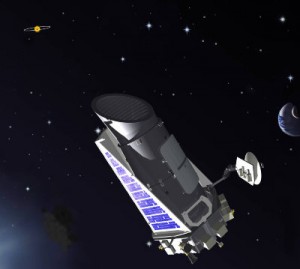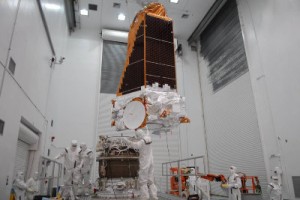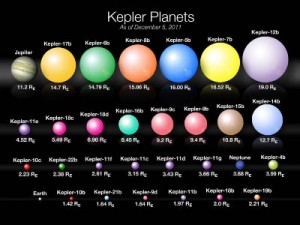On March 6th, 2009, a Delta II rocket was launched from the Cape Canaveral Air Force Station in Florida carrying a payload designed by NASA to be the first that searches for Earth-like planets in our own galaxy. The Kepler space observatory which NASA launched that day was charged with surveying the Milky Way galaxy to find terrestrial planets of a similar size to Earth within the galaxy. Originally scheduled to operate for three-and-a-half years, Kepler, like many other NASA spacecraft, has been able to transcend its initial mission and it continues to be a potential source of new scientific discoveries to this day.
Kepler’s search has been focused on the many exoplanets that exist in our solar system but which orbit a star other than our Sun. Research on exoplanets has increased tremendously over the course of the past two decades, during which time have scientists found thousands of such specimens. The interactive Exoplanets Data Explorer, made available online as a joint project of the University of Massachusetts and the Infrared Processing and Analysis Center (IPAC) at Caltech, currently lists more than 5,000 candidate planets and 1,618 planets with good orbits around a star. Of particular interest are exoplanets that exist within the habitable zone, which is a scientific concept somewhat loosely defined as those planets having the right size and orbit to support surface liquid.
The Kepler spacecraft is named after 17th-century astronomer Johannes Kepler, born in December 1571 in Weil der Stadt, a city in the Stuttgart Region of Germany which was part of the Holy Roman Empire during Kepler’s life. A champion of the heliocentric Copernican model of our solar system, Kepler worked with other famed Renaissance-era astronomers such as Tycho Brahe and Galileo Galilei. He published his most influential work on the heliocentric system in 1621, the Epitome Astronomiae Copernicanae, which provided what was at that time the world’s most thorough systematic approach to the heliocentric model. Religious issues with both the Lutheran and Catholic churches would afford Kepler little safety during the Thirty Years’ War and died in 1630 while on a trip to collect on a debt.
As always, the scientific components of this NASA mission craft are the result of a great deal of scientific research and no small amount of ingenuity to produce the ultra-sensitive tools which are necessary for space science. Kepler was designed to take images of space using a single-purpose photometer instrument, a Schmidt telescope design with a 0.95 meter aperture having a 12 degree diameter field of view. The photometer is itself comprised of 42 charge coupled devices (CCDs), each of which has 2200-by-1024 pixel resolution. The photometer is sensitive enough to detect an Earth-sized transit of a solar-like star.
To keep the photometer’s field of view in the proper plane so as not to be blocked periodically by the sun, Kepler was launched by the Delta II rocket in a way specifically designed to help the craft achieve an Earth-trailing heliocentric orbit, basically following the Earth around the Sun. This particular orbit creates very-low disturbing torque on the spacecraft caused not by gravitation forces from the Earth but solar pressure from the Sun. Completing the equipment requirements necessary to perform the scientific experiments for which Kepler was designed is the data archive which takes raw data collected by Kepler for processing at NASA’s Ames Research Center in Moffett Field, CA. This processing calibrates the images and removes bias as well as smear caused by the lack of any shutter on the photometer. This is the raw data used by scientists to conduct research into exoplanets.
At this point, some readers may have already asked themselves, “But wasn’t the Hubble Space Telescope already sending us amazingly detailed images of the far reaches of space? Didn’t you even cover last year’s 25th anniversary of the first images sent by Hubble to NASA from space? Why send Kepler up to capture images if we had a working, very expensive telescope already out there?” All of those are fantastic questions, and it turns out that the two craft are designed to accomplish very different jobs, despite the fact that both are essentially incredibly high-level cameras. Perhaps it can be best understood as the difference between looking at a single stage actor within a spotlight versus watching a full-length movie displayed on a wide screen. Kepler is watching the wide-screen movie; its field of view is designed to track more than 100,000 main-sequence stars to gain information on countless other planetary bodies. Hubble is the spotlight that can’t be everywhere at once but can shine a bright light on an incredibly distant patch of space, grabbing accurate images of galaxies many billions of light years away in a way that Kepler couldn’t pinpoint, and in fact doesn’t need to because its mission is focused on our own Milky Way Galaxy. For more comparison, Kepler’s field of view is about 30,000 times larger than Hubble’s field of view. The reason why both telescopes are in space and not on Earth is because our planet’s atmosphere contains air pockets which can prevent highly accurate imaging of the deep reaches of space.
In the first phase of Kepler’s mission, the craft spent four years monitoring more than 150,000 stars in an area of space containing the Cygnus and Lyra constellations. To detect exoplanets in that region, Kepler searches for transit events during which a planetary body crosses between Kepler and a star. When this happens, the brightness which Kepler detects from that star dips and scientists can begin calculating the planet’s orbital size based upon the length of time that planet needs for an orbit and the star’s mass using equations based upon Kepler’s third law of planetary motion in which the square of any planet’s period, or length of orbit, is proportional to the cube of the semimajor axis of that planet’s orbit (the semimajor axis is the radius of an elliptically-shaped orbit from the center of that orbit to the furthest point on the ellipsis).
This first phase led to incredible discoveries based on Kepler data, including thousands of transiting exoplanets and the discovery of small planets where life is much more likely to form. The scientific community is clear that there are an abundance of exoplanets. Gas giants, which are similar to Jupiter, Saturn and Neptune in our own solar system, make up a quarter of all discovered exoplanets, have masses ten times that of our own Earth and are composed primarily of hydrogen or helium possibly surrounding a core of rock or ice. Super Earths have a mass which is less than 10 times the mass of Earth but made up of any composition of gas, liquid or solids. Of course, the environment required for any type of life, not just human, is incredibly specific and the Habitable Exoplanets Catalog published by the Planetary Habitability Laboratory at the University of Puerto Rico at Arecibo lists a total of 33 potentially habitable exoplanets other than Earth in the Milky Way Galaxy, the closest of which is 13 light years away. 22 of these are Super Earths, 11 are close to Earth-sized and none are smaller than Earth.
In August 2013, the first phase of Kepler’s mission ended was officially ended by NASA after the second of four reaction wheels had malfunctioned that May and couldn’t be fixed, preventing the spacecraft from being able to position the telescope aimed at the Cygnus-Lyra region. It snuffed out a newly planned Kepler mission approved by NASA in 2012 but that was replaced by K2, a mission involving a series of sequential field observations of regions of space for periods up to 83 days, when interference from the Sun requires that the telescope be repositioned. For the K2 mission, Kepler achieves stability in three directions through the use of the remaining two reaction wheels, which maintain the orientation of the spacecraft in a position nearly parallel to its orbital path. This allows solar pressure coming from the Sun to act as the third reaction wheel that balances the spacecraft, enabling long-term focus on a particular field of view.
When the K2 mission became fully operational in July 2014, it was supposed to run until 2018 at the latest. This timeline was threatened, however, when a routine contact with the spacecraft this April uncovered the fact that Kepler had placed itself in emergency mode, preventing NASA engineers from completing a planned Kepler maneuver. Within a week, however, NASA was able to recover Kepler from emergency mode which allows the telescope to enter a new phase of research, which will see Kepler survey millions of stars at the center of the Milky Way.
Kepler’s impact on the scientific body of knowledge of the space within our own galaxy has been tremendous. It’s the first telescope to detect an Earth-like planet within the habitable zone of a star, a task made difficult because of the small size relative to other planets and the distance of the planetary body. It has confirmed 1,041 exoplanets and it continues to search for those along with flaring stars, binary stars, asteroids and much more. Years of research will provide insight into the type of exoplanets revolving around certain stars as well as knowledge of exoplanet atmosphere thanks to spectrometry techniques. The K2 mission is currently applying gravitational microlensing techniques to images captured by Kepler, relying on the noticeable effect which the gravity of massive stars has on light which warps around smaller bodies close to the star.

![[IPWatchdog Logo]](https://ipwatchdog.com/wp-content/themes/IPWatchdog%20-%202023/assets/images/temp/logo-small@2x.png)



![[[Advertisement]]](https://ipwatchdog.com/wp-content/uploads/2024/04/Patent-Litigation-2024-banner-938x313-1.jpeg)

![[Advertisement]](https://ipwatchdog.com/wp-content/uploads/2024/04/UnitedLex-May-2-2024-sidebar-700x500-1.jpg)
![[Advertisement]](https://ipwatchdog.com/wp-content/uploads/2024/04/Artificial-Intelligence-2024-REPLAY-sidebar-700x500-corrected.jpg)
![[Advertisement]](https://ipwatchdog.com/wp-content/uploads/2024/04/Patent-Litigation-Masters-2024-sidebar-700x500-1.jpg)

![[Advertisement]](https://ipwatchdog.com/wp-content/uploads/2021/12/WEBINAR-336-x-280-px.png)
![[Advertisement]](https://ipwatchdog.com/wp-content/uploads/2021/12/2021-Patent-Practice-on-Demand-recorded-Feb-2021-336-x-280.jpg)
![[Advertisement]](https://ipwatchdog.com/wp-content/uploads/2021/12/Ad-4-The-Invent-Patent-System™.png)






Join the Discussion
No comments yet.